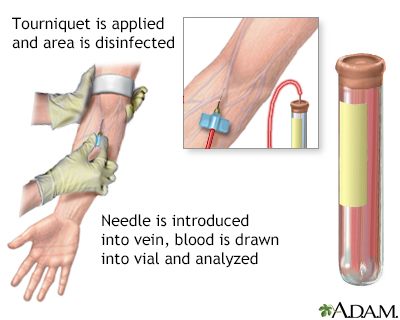
Histoplasma antibody test
Histoplasma complement fixation is a blood test that checks for infection by a fungus called Histoplasma capsulatum (H capsulatum), which causes the disease histoplasmosis.

The sample is sent to a lab. There it is examined for histoplasma antibodies using a lab method called complement fixation. This technique checks if your body has produced substances called antibodies to a specific foreign substance (antigen), in this case H capsulatum.
Antibodies are specialized proteins that defend your body against bacteria, viruses, and fungi. If the antibodies are present, they stick, or fix themselves, to the antigen. This is why the test is called fixation.
There is no special preparation for the test.
When the needle is inserted to draw blood, some people feel moderate pain. Others feel only a prick or stinging. Afterward, there may be some throbbing or bruising. This soon goes away.
The test is done to detect histoplasmosis infection.
The absence of antibodies (negative test) is normal.
Abnormal results may mean you have an active histoplasmosis infection or have had an infection in the past.
During the early stage of an illness, few antibodies may be detected. Antibody production increases during the course of an infection. For this reason, this test may be repeated several weeks after the first test.
People who have been exposed to H capsulatum in the past may have antibodies to it, often at low levels. But they may not have shown signs of illness.
There is little risk involved with having your blood taken. Veins and arteries vary in size from one person to another, and from one side of the body to the other. Taking blood from some people may be more difficult than from others.
Other risks associated with having blood drawn are slight, but may include:
Aoyagi K, Ashihara Y, Kasahara Y. Immunoassays and immunochemistry. In: McPherson RA, Pincus MR, eds. Henry's Clinical Diagnosis and Management by Laboratory Methods. 24th ed. Philadelphia, PA: Elsevier; 2022:chap 45.
Deepe GS. Histoplasma capsulatum (histoplasmosis). In: Blaser MJ, Cohen JI, Holland SM, et al, eds. Mandell, Douglas, and Bennett's Principles and Practice of Infectious Diseases. 10th ed. Philadelphia, PA: Elsevier; 2026:chap 269.
Thompson GR, Miceli MH. Endemic mycoses. In: Goldman L, Cooney KA, eds. Goldman-Cecil Medicine. 27th ed. Philadelphia, PA: Elsevier; 2024:chap 308.
BACK TO TOPReview Date: 5/12/2025
Reviewed By: Jatin M. Vyas, MD, PhD, Roy and Diana Vagelos Professor in Medicine, Columbia University Vagelos College of Physicians and Surgeons, Division of Infectious Diseases, Department of Medicine, New York, NY. Also reviewed by David C. Dugdale, MD, Medical Director, Brenda Conaway, Editorial Director, and the A.D.A.M. Editorial team.

|
A.D.A.M., Inc. is accredited by URAC, also known as the American Accreditation HealthCare Commission (www.urac.org). URAC's accreditation program is an independent audit to verify that A.D.A.M. follows rigorous standards of quality and accountability. A.D.A.M. is among the first to achieve this important distinction for online health information and services. Learn more about A.D.A.M.'s editorial policy, editorial process and privacy policy. A.D.A.M. is also a founding member of Hi-Ethics and subscribes to the principles of the Health on the Net Foundation (www.hon.ch). |
The information provided herein should not be used during any medical emergency or for the diagnosis or treatment of any medical condition. A licensed medical professional should be consulted for diagnosis and treatment of any and all medical conditions. Call 911 for all medical emergencies. Links to other sites are provided for information only -- they do not constitute endorsements of those other sites. © 1997- A.D.A.M., Inc. Any duplication or distribution of the information contained herein is strictly prohibited.